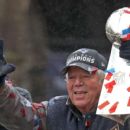PITTSBURGH — The Pittsburgh Steelers are on record as wanting to improve quarterback depth behind Ben Roethlisberger. They have resources to do just that, and they don’t have to use the NFL draft — at least not yet.
Re-signing Landry Jones is a possibility, but if the team opts for a seasoned backup while grooming a draft pick over the next two to three years, there’s enough help available.
It’s not great help, but it’s serviceable help — players who can assume a No. 2 or No. 3 role on the depth chart. In a bind, these quarterbacks can win a game or two.
Some big names could be available. Simple math says that a few established starters will find themselves second-stringers come August. How many teams unquestionably need a new quarterback in 2017? Let’s say four: Chicago Bears, Cleveland Browns, New York Jets and San Francisco 49ers. The Buffalo Bills and Houston Texans appear in that next tier. So if two of those first four draft a first-round quarterback and the other two trade for Jimmy Garoppolo or Tony Romo, that leaves the Colin Kaepernick/Jay Cutler crowd low on guarantees and depth-chart positioning. The wild card is Mike Glennon, whom the Tampa Bay Buccaneers believe can be a legitimate starter in the NFL.
Below are quarterbacks who are realistic options if the Steelers are so inclined:
Colin Kaepernick: Kaepernick won’t exactly have a robust market if/when he opts out of his contract in San Francisco. He’d be an entertaining backup in Pittsburgh, which can redo the Mike Vick signing from two years ago with a younger and faster model. Kaepernick posted a respectable 90.7 passer rating with minimal playmakers in San Francisco last year. He could be worth high-level backup money somewhere.
Brian Hoyer: He has been a solid option in his last three stops, with 25 touchdowns compared to seven interceptions over his past 17 regular-season games. He spent a brief period with Pittsburgh in 2012, so he’d grasp Todd Haley’s system quickly.
Landry Jones: He’s taken hundreds — no, thousands — of reps in that system. This qualifies him as perhaps the most equipped option out there. He recovered well from an uneven first two years on the job. The Steelers like the hard-working Jones. Overall, though, he doesn’t elicit a lot of confidence for the long term, so any re-signing would likely be on a bridge, two-to-three-year deal.
Matt Cassel: Not sure how much he has left at age 34, but he spent time with Haley in Kansas City and would be a valuable voice in the quarterback room.
Josh McCown: He’s a good guy to have in a locker room. He acquitted himself well in Cleveland with toughness and he averaged 264 yards per game in eight starts in 2015. He could join the team on a reasonable one- to two-year deal.
Ryan Fitzpatrick: Fitzpatrick just finished a polarizing two seasons with the New York Jets, but he’s still less than two seasons removed from a 31-touchdown season. Fitzpatrick has a penchant for interceptions. Still, his backup quarterback resume is extensive.
Case Keenum: His two-season stint as a Rams starter unraveled in 2016, but the lack of playmakers around him was glaring. Keenum’s true identity is as a primary backup who can start a handful of games if the starter goes out.







